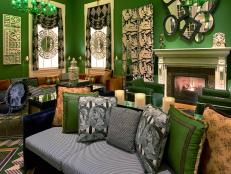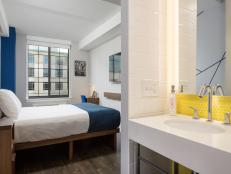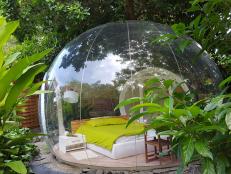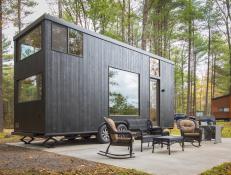10 Hotels With Iconic Southwest Design
In the Southwest, Anglo, Spanish, and Native American cultures come together with a dash of cowboy fantasy to create a one of a kind of design aesthetic suited to the region’s giant landscape and infinite sky.

Related To:

Photo By: Dylan Cross/Dragonfly Image Part
Photo By: Robert Reck Photography
Photo By: Twin Lens
Photo By: ELIAS BUTLER PHOTOGRAPHY
Photo By: Durston Saylor
Photo By: Barbara Kraft
Hermosa Inn
Paradise Valley, Arizona
This adobe inn began its life in the 1930s as the home and studio of cowboy artist Lon Megargee. He built the place himself with adobe bricks made onsite. The building features traditional Southwestern architecture with hand-carved wooden doors, kiva fireplaces and Spanish colonial corbels. Its gardens feature hundreds of cacti and other desert natives, as well as some drought-hardy, non-native plants that have been coaxed to life through the magic of irrigation. The hotel also has a large collection of Megargee’s work on display, as well as an artist-in-residence who makes art while you watch.
La Fonda on the Plaza
Santa Fe, New Mexico
This Santa Fe landmark was built in 1922 and was one of the original Harvey House Hotels along the legendary Atchison, Topeka and Santa Fe Railroad. Its adobe-walled, Pueblo-revival architecture is classic New Mexico, designed to fire the imagination of travelers who came West to see Indians and wild frontier. It sits at the end of the original Santa Fe Trail and there has been a hotel of some sort on the site for more than 400 years. The La Fonda’s rooms and public spaces have kiva fireplaces, handcrafted Spanish colonial furnishings, hammered tin light fixtures, brightly colored walls and tiles, Navajo rugs and hand-carved vigas. The hotel is full of art by Native American artists from the area’s pueblos.
Enchantment Resort
Sedona, Arizona
The Native American culture of northern Arizona is in the architecture at Enchantment Resort. The adobe structure is just 30 years old but its low-slung casitas blend into the iconic red walls of Boynton Canyon, reminiscent of the ancient cliff dwellings of the Anasazi who lived in the Southwest a millennia ago. Even though the place isn’t Native-owned, there are Native American flute players in the lobby, Native ceremonies at the equinoxes, and the onsite restaurant, Che-Ah-Chi, takes its name from the Apache name for the area. The decor is a sleek contemporary take on Southwestern rustic, with pricier rooms sporting viga-and-latilla ceilings and kiva fireplaces.
Los Poblanos Historic Inn & Organic Farm
Albuquerque, New Mexico
This 1930s farm turned bed and breakfast in the Rio Grande Valley was designed by John Gaw Meem, the legendary architect who created Santa Fe style. The main house is adobe and built in New Mexico territorial style, a look that came into vogue in the 19th century and incorporated materials from the bricks, larger doors and windows, and more ornate trim. The grand portal (above) features murals above the windows painted by WPA artist Harry Garrison Miller. The property’s formal Spanish-style gardens, with a cottonwood allee, rose gardens and Spanish tile fountains were designed by Rose Greely, a pioneer female landscape architect. The farm grows organic vegetables used to make entrees at its onsite restaurant and lavender that’s used in a line of spa products.
Taos Inn
Taos, New Mexico
This funky hotel in downtown Taos is hippie fabulous New Mexico at its finest. Once a block of 200-year old adobe houses, the inn’s original owners bought all of them in the 1930s and turned them into a rambling hotel. The inn’s 44 rooms have kiva fireplaces, two-foot-thick adobe walls and Spanish colonial furnishings, pure northern New Mexico. The neon thunderbird sign out front advertises cocktails, curios and vacancies, pure roadside Americana. Its restaurant, Doc Martins, named for the town doctor who was the inn’s original owner, serves local favorites like chile rellenos, green chile stew and blue corn enchiladas.
Inn and Spa at Loretto
Santa Fe, New Mexico
Built on the site of a Catholic school that closed in the late 1960s after more than a century, the Inn and Spa at Loretto is four stories of Pueblo-style perfection. It was constructed in the early 1970s when adobe, one of the most ancient building materials on the planet, came back into vogue and is an icon of Santa Fe style. You can stay in rooms decorated with cow skulls and kivas, get a Zero Gravity Manicure or head next door to the Loretto Chapel, built in the 1870s and the only structure from the school remaining, to figure out how the spiral Miraculous Staircase manages to stand without a center support. Legend says St. Joseph the Carpenter, aka Jesus’ dad, built it, which locals say is the reason it doesn’t adhere to local building codes or the laws of physics.
Rosewood Inn of the Anasazi
Santa Fe, New Mexico
This hotel was built in the early 1990s but like the best Pueblo revival buildings, it looks centuries old. It has thick, earth-colored adobe walls, a flat roof, zigzag balcony railings and logs jutting out of the exterior walls. Rooms have viga-and-latilla ceilings, kiva fireplaces, tribal pottery, and fabrics made by New Mexico artisans. There’s some transitional-style furniture mixed in to keep the rooms on the boutique hotel end of Santa Fe style. There’s also a dedicated tequila bar with 70 brands of agave squeezins on the menu, so you sit on the Anasazi’s front patio and contemplate Santa Fe’s street scene while sipping Casa Dragones.
Arizona Inn
Tucson, Arizona
Not all southwestern hotels have brown walls. At the Arizona Inn, they’re pink, and the grounds are full of palm trees, and manicured green lawns, not creosote bushes and cactus. It’s an old-school resort that’s Mediterranean Revival with a touch of traditional Southwestern, a genteel place where high tea is served daily in the library beneath a viga ceiling, and the harshness of the desert and midtown Tucson is kept out by tall pink walls. The 14-acre resort was built in 1930 by the state’s first Congresswoman and BFF of Eleanor Roosevelt, Isabella Greenway. Her granddaughter still owns the place.
Inn of the Five Graces
Santa Fe, New Mexico
Arabian Nights meet the Southwest at this lavishly decorated bed and breakfast tucked into downtown Santa Fe just off the Old Santa Fe Trail. Originally a cluster of traditional adobe houses, its antique dealer-owners turned the place into a fantasy of dazzling mosaics, doors rescued from old world ruins, Tibetan artifacts, Kilim rugs, beehive fireplaces and Chihuly light fixtures. It’s a rush of color and creative energy, the ultimate luxe hippie destination. The city’s famed Canyon Road art district is in the neighborhood, along with San Miguel Chapel, a 400-year-old Spanish mission church.
Four Seasons at Troon
Scottsdale, Arizona
This swanky resort sits atop Pinnacle Peak outside Scottsdale, Ariz., Santa Fe’s matronly Republican sister. It has Pueblo-revival style going on but its walls are sensible stucco, not exotic adobe. Casitas and suites have kiva fireplaces, with the suites going all-out Santa Fe viga-and-latilla ceilings, wood floors and Spanish colonial iron light fixtures. The grounds are landscaped with native desert plants, embracing the arid surroundings instead of covering them with turf grass and boxwoods. There’s a spa, golf, restaurants and a bar. Four Seasons also offers hikes into the desert to gaze at stars and tequila tastings. Try pairing the two for maximum effect.






